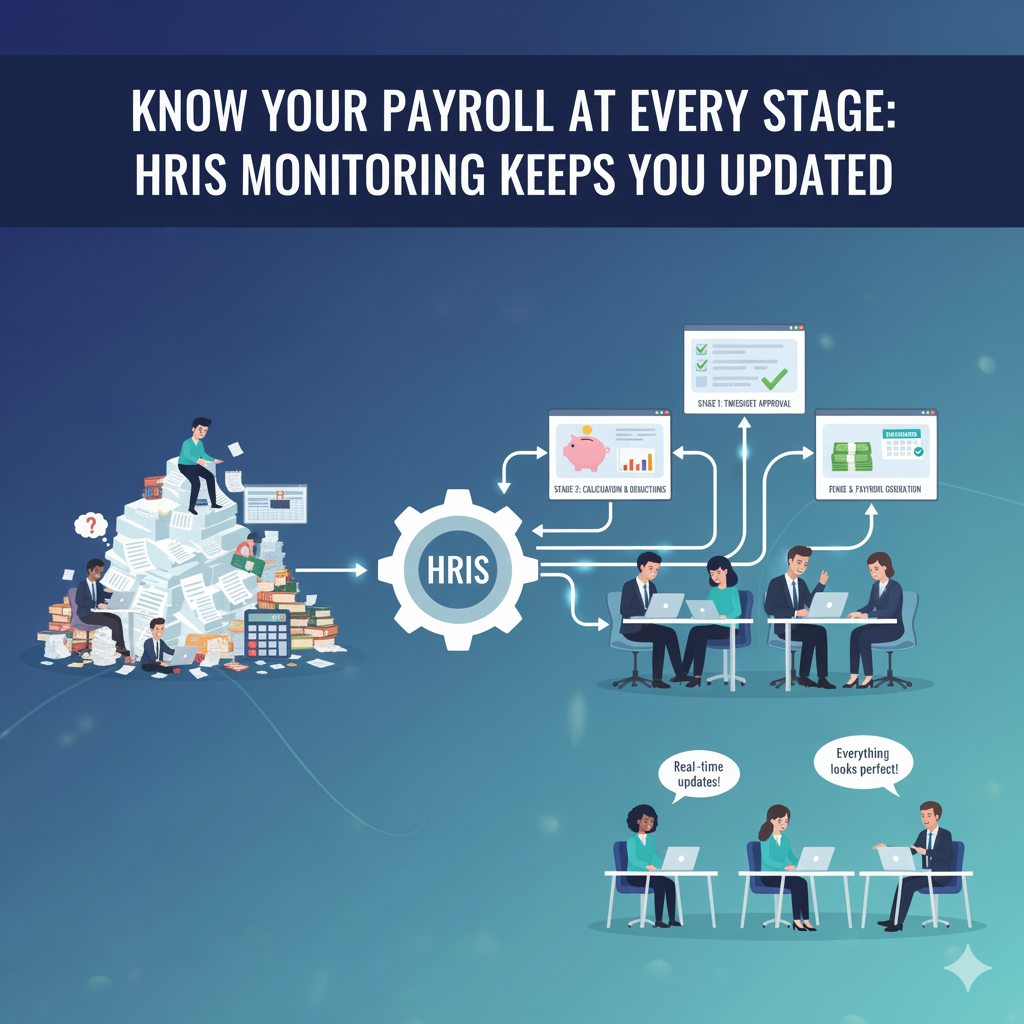Payroll is the lifeblood of employee satisfaction — and one of the most complex administrative tasks for HR departments. From timekeeping to approvals and final disbursement, each payroll cycle involves multiple steps, data points, and coordination between teams.
Without proper monitoring, even a small delay or calculation error can snowball into employee dissatisfaction, compliance issues, and financial discrepancies.
That’s where Human Resource Information Systems (HRIS) come in — providing real-time payroll monitoring tools that help you track progress, ensure accuracy, and stay in control at every stage.
What Is Payroll Monitoring in HRIS?
Payroll monitoring in an HRIS system refers to the ability to track and manage the payroll process in real-time — from initial data input to final posting and release.
Through intuitive dashboards, HR and finance teams can:
- See which payroll batches are pending, in process, or completed
- Monitor approval workflows and identify bottlenecks
- Verify computation accuracy and detect discrepancies early
- Maintain a digital audit trail for transparency and compliance
In essence, HRIS payroll monitoring ensures visibility and control — eliminating the guesswork from payroll management.
Challenges of Manual Payroll Tracking
Companies that still rely on spreadsheets or disconnected tools face common problems such as:
❌ Lack of visibility: Teams can’t easily tell which payroll batches are done or delayed.
❌ Communication gaps: HR, accounting, and management may be out of sync during processing.
❌ Error-prone tracking: Manual updates increase the risk of incorrect data or duplicated entries.
❌ Compliance risks: Delays or miscalculations can lead to penalties or employee grievances.
Manual monitoring might seem manageable for small teams — but as a company scales, it becomes inefficient and risky.
How HRIS Payroll Monitoring Works
Modern HRIS platforms are designed to automate and visualize the payroll process. Here’s how HRIS payroll monitoring keeps your team informed at every stage:
- Real-Time Status Tracking
The HRIS dashboard displays live payroll status updates — such as Pending Computation, Under Review, Approved, or Released.
You can instantly see which batch is ready for processing and which needs attention. - Automated Notifications and Alerts
HRIS systems can send automated alerts to HR managers and payroll approvers whenever a task requires action.
For example:
“Payroll Batch 2025-10 — Awaiting Manager Approval.”
No more missed deadlines or bottlenecks. - Data Integration Across Modules
Because HRIS integrates attendance, timesheets, leave data, and compensation, it ensures that payroll calculations are always based on the latest and most accurate information. - Approval Workflow Visibility
With built-in workflow tracking, HRIS users can view who has approved or is yet to approve payroll batches — ensuring accountability and traceability. - Reporting and Analytics
HRIS payroll modules generate detailed reports that show processing times, error logs, and batch performance — valuable insights for improving future cycles.
Key Benefits of HRIS Payroll Monitoring
Switching to HRIS for payroll status tracking brings measurable advantages:
✅ 1. Improved Accuracy
By automating data collection and status tracking, HRIS minimizes human error — ensuring consistent, compliant payroll results.
✅ 2. Real-Time Transparency
HR managers, accountants, and executives can all see payroll progress in real-time, promoting accountability and collaboration.
✅ 3. Faster Payroll Cycles
Automated alerts and streamlined approvals reduce waiting time between processing stages, helping teams meet payment deadlines effortlessly.
✅ 4. Better Compliance and Audit Readiness
With digital records of every action taken, HRIS makes it easier to meet legal requirements and prepare for audits — without the paper trail chaos.
✅ 5. Higher Employee Trust
When payroll is consistent and on time, employees gain confidence in the company’s HR processes — leading to greater satisfaction and loyalty.
Real-World Example: From Chaos to Clarity
- A mid-sized company managing 400 employees used to spend two full weeks finalizing payroll each month.
- Status updates were shared via email and spreadsheets, causing frequent miscommunication and late releases.
After implementing an HRIS payroll monitoring system, the company saw immediate improvements:
- Payroll turnaround time reduced by 60%
- HR team gained real-time visibility on batch progress
- Approvals were automated through in-system notifications
- Audit trails became fully digital
The result? Faster, more accurate payroll with fewer headaches.
Best Practices for Payroll Monitoring in HRIS
To maximize efficiency and reliability, HR teams should:
🧾 Regularly update employee records before payroll runs
🔍 Review computation logs for discrepancies before approvals
📅 Set up recurring reminders for payroll cycles and cutoff periods
📊 Leverage HRIS analytics to identify recurring issues
🧠 Train HR and finance staff to use monitoring dashboards effectively
When these practices are in place, payroll monitoring becomes not just a task — but a strategic advantage.
Conclusion
In today’s fast-paced business environment, real-time payroll visibility isn’t just a convenience — it’s a necessity.
With an HRIS system, you can monitor payroll at every stage, eliminate confusion, and ensure that employees are paid accurately and on time.
The days of manual tracking and endless spreadsheets are over.
Empower your HR and payroll teams with HRIS payroll monitoring — and turn payroll from a monthly challenge into a smooth, transparent, and reliable process.

